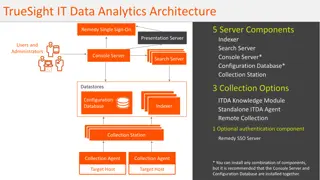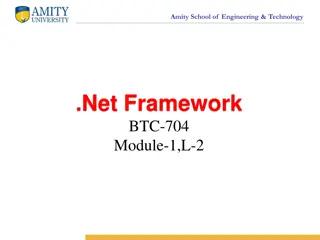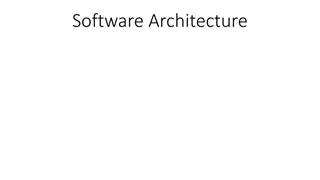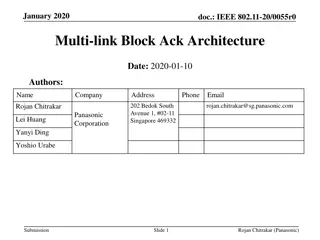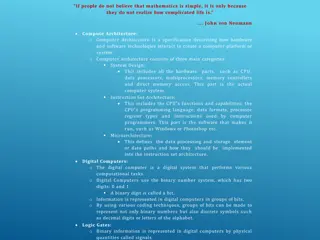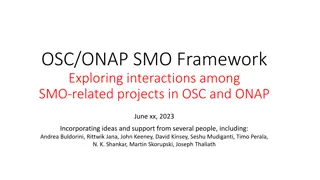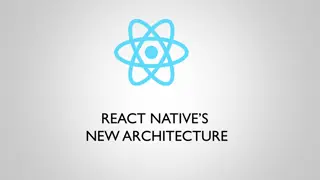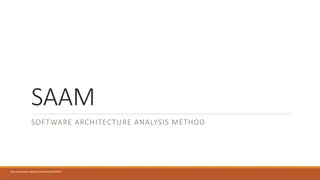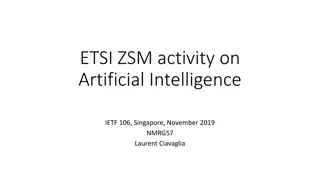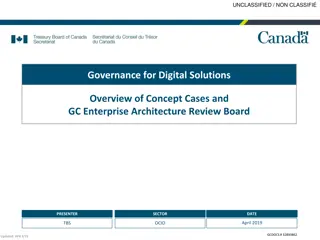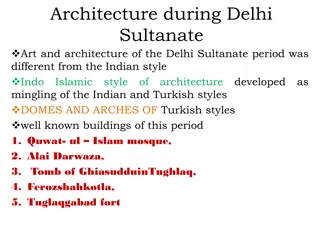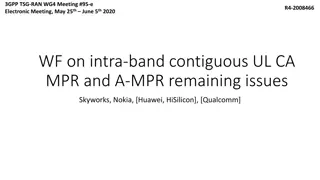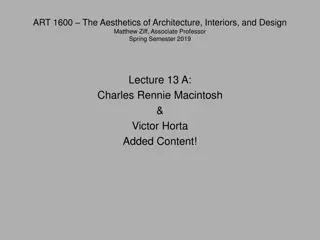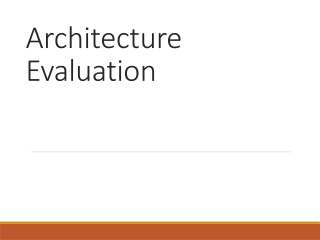Understanding Reltio Data Model and Architecture
Reltio offers a dynamic and metadata-driven data model that simplifies database modeling and allows for easy changes without impacting the underlying storage. Key differences between Reltio and relational models include multi-valued attributes, nested attributes, and built-in address cleanse engine. The n-layer configuration architecture of Reltio enables customization for different tenant needs and accelerates pre-integration speeds. Overall, Reltio's model avoids many common data modeling issues and facilitates efficient data management.
Download Presentation

Please find below an Image/Link to download the presentation.
The content on the website is provided AS IS for your information and personal use only. It may not be sold, licensed, or shared on other websites without obtaining consent from the author. Download presentation by click this link. If you encounter any issues during the download, it is possible that the publisher has removed the file from their server.
E N D
Presentation Transcript
Reltio Data Model 1 CONFIDENTIAL AND PROPRIETARY |
Agenda Reltio Data Model vs Legacy data model Reltio multi layer architecture Reltio Accelerators Guidelines & Best practices Use Case 2 CONFIDENTIAL AND PROPRIETARY |
Legacy Data model Identify Entities Attributes Relationships (1:1, 1:M, M:M) Create Logical model Convert Logical model to physical model Normalization/Denormalization Bridge tables due to M:M relationships Multi value attributes etc. 3 CONFIDENTIAL AND PROPRIETARY |
Reltio Data Model Dynamic Model: The Reltio model is metadata driven and can help avoid many of these issues. Traditional database modeling iteratively can become tedious. Even small changes in a data model - such as making an organization name a multi- valued attribute - can result in costly data migration projects, or rely on temporary workarounds just to make things work, until the next change is made in the model. The Reltio model can be changed dynamically without making changes to the underlying physical storage. The Reltio UI reflects these model changes automatically and instantly. 4 CONFIDENTIAL AND PROPRIETARY |
Key differences between Reltio and relational models are Every attribute in Reltio is multi-valued. This eliminates the need to model additional tables to support this functionality. Reltio supports nested attributes to remove the need for 1->M dependent entities. Attributes can be deeply nested, which eliminates the need for cascading joins. This eliminates the need for frequent foreign key resolution. Reltio allows addresses to be modeled as nested attributes and the built-in address cleanse engine handles this model seamlessly. Reltio RDM can be used to model reference data without the need for a large number of reference data tables. This can greatly simplify the model. 5 CONFIDENTIAL AND PROPRIETARY |
Introducing Reltio n-layer Configuration Architecture Any part of Meta Object Model can be defined in any Layer Objects are available to a Customer tenant Customer Layer can Accept Override Extend Ignore Objects are available to vertical tenants Objects are available to ALL tenants Layer 3 Customer extensions (extended by customer) Reltio controls Layers 1, 2 created industry models learns from customer feedback leverages these layers for accelerated pre-integration speeds up time to deployment Layer 2 Reltio Verticals (maintained by Reltio) Reltio Entity Types: Party Individual Organization Location Product Layer 1 Reltio Core (maintained by Reltio) 6 CONFIDENTIAL AND PROPRIETARY | Confidential and Proprietary please do not distribute without prior permission 6
Introducing Reltio n-layer Configuration Architecture Objects for other Customer Regions Objects for Customer Global Objects for vertical tenants Layer 4 Local Regions (extended by customer) Objects for ALL tenants Layer 3 Amgen Global (extended by customer) Layer 2 Reltio Verticals (maintained by Reltio) Layer 1 Reltio Core (maintained by Reltio) Confidential and Proprietary please do not distribute without prior permission 7 7 CONFIDENTIAL AND PROPRIETARY |
3-layer referencing and inheritance 8 CONFIDENTIAL AND PROPRIETARY |
Radically Simplified Approach to Data Model Entities Attributes Relationship Types Attributes Hierarchies (GraphType) Entities Entities Entities Entities Entities Entities GraphType Entities Entities Interactions Transactions The Reltio meta model supports additional concepts: Unlimited attribution - objects (entities, relationships) can have unlimited attributes Matching and merging exact and fuzzy matching with survivorship rules and multiple best versions of the truth Crosswalks maintenance to support unlimited number of contributing and non-contributing source records Change History complete support for bi-temporal history and point in time views Audit and Lineage always know who, when and what the Transactions Transactions Relationships Transactions Transactions A true multi-domain environment 9 CONFIDENTIAL AND PROPRIETARY | Confidential and Proprietary please do not distribute without prior permission 9
Entity Types An entity can be a thing, person, place, or object. Data is stored for an entity in Reltio. Entity Type identifies the various kinds of nodes that will be used in graphs (e.g., Person , Organization ) An Entity Type corresponds to the generic concept of a category or a class Entity Type defines a set of entities that have same set of properties (and attributes) Entity Types can have taxonomies Confidential and Proprietary please do not distribute without prior permission 10 10 CONFIDENTIAL AND PROPRIETARY |
Attribute Types Examples Simple attributes Based on primitive data types, such as: String Int Float Date Blob Based on smart data types, such as: Image - can be marked to use for custom entity logo URL text from the URL can be indexed for full text search SSN# - predefined rules for validation and formatting Id such as passport, license, etc Email validation and formatting rules email-domains - Company email domains ticker-symbol - Company ticker identification for the stock exchange Enums Simple enums such as list of stock exchanges Hierarchical enums taxonomy/hierarchy of enum values. Example Tokyo is Japan, Japan is Asia, etc. so if somebody searches by Asia it will return records with values for Tokyo Lookups dynamic enums Nested attributes To support complex attributes for a Business Object. For example, University, year of graduation and degree is a combination of attributes that would be tracked together Reference attributes Provide support for complex structures in a Business Object. For example, if you have Entity types of Person, Address and Company, you can create a Business Object for Person with multiple addresses, companies, etc. In such a case the multiple addresses for this person are maintained as references (relationships) to various address entities Reference attributes contain relationship attributes that include both system and user defined attributes Reference attributes allow you to use any combination of entity types within a Business Object 11 11 CONFIDENTIAL AND PROPRIETARY |
Relationship Types Define links between objects: Entity-Entity Entity-Relationship (T-relations) Support Taxonomies Have directional context based on rules Confidential and Proprietary please do not distribute without prior permission 12 12 CONFIDENTIAL AND PROPRIETARY |
Graph types Logical containers for a set of Entities, Groups and Relationships Graph types are defined and controlled by: graph type objects rule - a rule that defines what entities can be a part of group a set of possible relationship types Graph types are convenience functions that allow: Retrieval of entities, groups and relationships Maintenance of entities, groups and relationships Graph type is like a pattern - it filters out relationships and leaves only relationships of certain types that are defined for it Graph types can have attributes: System attributes Tags Simple attributes Complex attributes Graph type properties include: Visualization layout Style settings Validation settings Confidential and Proprietary please do not distribute without prior permission 13 All Relationships Graph Type container 13 CONFIDENTIAL AND PROPRIETARY |
Reltio Accelerators Reltio provides default out of the box multi layer configuration. Please use following approach for defining new entities. a. If customer vertical has defined Reltio L2, please use the L2 entities already defined. Following are the existing L2 configuration available today: Repository: https://bitbucket.org/reltio-ondemand/workspace/projects/ROCS Life-Sciences Consumer360 Account360 LSProduct360 a. b. Identify the existing (L1/L2/L3) entity and relationships types Use L2 entities for defined verticals and extend them in L3 for customization. Define new attributes only if they do not exist in L1 or L2 Identify new entity types Identify new relationship types Identify new interaction types Identify the Reference data (RDM) c. d. e. f. 15 15 CONFIDENTIAL AND PROPRIETARY |
Entities/Model For New Verticals If the vertical is not defined in Reltio L2 or the information being stored cannot use one of the existing entities, we follow the below approach to define it as either an entity, RDM or a lookup. Below are some of the additional considerations when defining new entities: If not done correctly, entity modeling can adversely affect UI, data load, and matching performance. Please collect enough data points during initial phases to drive the modeling decisions. When modeling high cardinality relations, nested attributes are preferable over the reference attributes. Nested attributes perform better in terms of storage, and maintenance of data (create, update, delete etc.). When moving a MDM system originally defined in Relational databases, do not map entities directly to Reltio. Relito is non- relational and converting relational system to non-relational does not work. Instead, use the best practice guidelines (link given above) to convert relational entities to either Reltio entities, Reltio nested attributes, Reltio RDM objects or lookup as it fits based on the requirements. 16 16 CONFIDENTIAL AND PROPRIETARY |
Customer Data Model Legacy system modelled for relational databases Problem: Customer has large number of entities for their Organization and Site entities. The total volume was expected to be 250 million Organization and 380 million OPSI, and 380 million location entities. This creates challenges for data loads, UI and matching performance. The highly normalized data model also has many entities/tables defied for reference data, or to manage many to many relationships. Solution: 1. We merged location entity with Site, which reduced the 380 million relationship objects and 380 million location object. Also, it was determined that Site has only one address associated with it, which can easily be supported with this approach. Following are the gains received because of this change: - Dataload speed was 3.5 times higher, - Reindexing speed was 2 times higher for Site entity type with nested Address. - C* tables took 2.5 less space (less entities, no relationships, less activity and history data) 1. Modelled many legacy entities/tables which are truly a reference data as RDM objects. This reduced the overall complexity. This was slow moving data used mainly as qualifiers or list of values. If the source item is small collection of attributes (Code, Value, Description etc) and total number of records < 10K, it is recommended to be modelled as RDM object. This will reduce the number of relationships, references to other entities, resulting in a better performance. 2. Finally, the resulting model reflects the actual business entities and relationships much more clearly, without adding the technical complexities. 18 18 CONFIDENTIAL AND PROPRIETARY |






